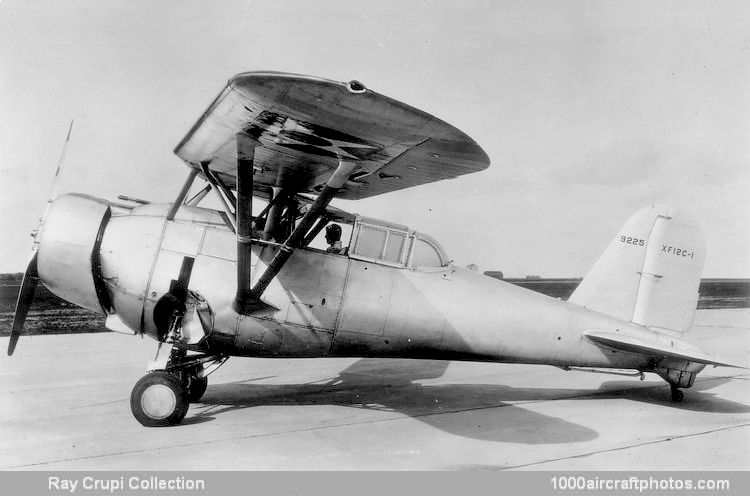XF12C-1. This was a two-seat monoplane fighter, BuNo. 9225, and it first flew in July 1933. The structure was all-metal except for fabric covering on the movable control surfaces and the flaps. Intended for use from carriers, the XF12C-1 was fitted with arrester gear and the first folding wing mechanism ever fitted to a fighter aircraft. Full-span leading edge slats were fitted. The wheels retracted into the lower fuselage as on the contemporary XF11C-3 Hawk. Forward armament reverted to a single 0.30 in (7.62 mm) caliber machine gun in a trough in the nose. Rear-cockpit armament was a single 0.30 in (7.62 mm) machine gun on a swivel mount. The power plant was the new 625 hp Wright SGR-1510-92 fourteen-cylinder two-row air-cooled radial engine, but this was unsatisfactory and was soon changed to the similar 775 hp Wright R-1670 which was also a new and unproved engine.
The XF12C-1 proved itself to be quite fast during tests at NAS Anacostia, Washington, D.C., in October and November 1933, recording a maximum speed of 217.4 mph (349.9 kmh). Because of slots and flaps, it had excellent landing characteristics. However, although filled with innovations, it was a two-seater, which effectively eliminated any pretense at agility, while its swept-back parasol wing was supported by long, drag-producing struts. Hence it was not accepted as a fighter simply because of its sluggishness.
XS4C-1. The Navy was aware of the XF12C-1's good points and it was considered for a scout assignment. In December 1933 it was re-evaluated following a further engine change to a 700 hp Wright SR-1820-80 Cyclone single-row nine-cylinder air-cooled radial engine with a revised cowling. Redesignated XS4C-1, the scout version was short-lived.
XSBC-1. In January 1934 came the final USN designation for the Model 73, XSBC-1, identifying it as a Scout-Bomber in that new combined category established in the same month. The well-proved Cyclone engine was more reliable than the previous experimental models and aeroplane performance was improved. During tests on June 14, 1934, the XSBC-1 crashed near Lancaster, New York and was promptly rebuilt. While on another test flight in September 1934, the wing folding mechanism failed, the wing swept backward and the airplane crashed again, pilot Paul Hovgard parachuting to safety. A new prototype was ordered in April 1935 with the same USN BuNo. 9225, but this time, Curtiss reverted to the biplane wing and the aircraft became the 77 XSBC-2 that won sizeable production orders."
|
|
XF12C-1 |
XSBC-1 |
